2. 北京大学, 造山带与地壳演化教育部重点实验室, 北京 100871
2. MOE Key Laboratory of Orogenic Belts and Crustal Evolution, Peking University, Beijing 100871, China
大兴安岭南段位于中亚造山带东段,地处古亚洲成矿域和滨西太平洋成矿域的交汇部位,构造演化复杂,成矿条件优越,是中国北方重要的有色金属矿产地(Wang et al., 2001; 刘建明等, 2004; 毛景文等, 2013; Ouyang et al., 2015)。长期以来,该区以盛产铅锌银矿床闻名,而近年来,大兴安岭南段多处锡多金属矿床的发现表明该区亦具有优越的锡成矿条件和巨大的找矿潜力(Zhou et al., 2012; Zhai et al., 2017; 陈公正等, 2018a; 刘瑞麟等, 2018; Mao et al., 2019; Mi et al., 2020)。前人的研究表明,该区锡多金属矿床常赋存于前中生代地质体,特别是晚古生代地层和华力西期岩体之中(Zhou et al., 2012; Zhai et al., 2017; 陈公正等, 2018a; 刘瑞麟等, 2018)。鉴于本区锡多金属矿床和成矿岩体之间复杂的空间关系,且由于以前缺少对锡多金属矿床定年的有效方法,导致部分矿床的成矿时代争议较大,如:白音诺尔矿床存在燕山期成矿(蒋斌斌等, 2020),印支期和燕山期两期成矿(Jiang et al., 2017)的不同认识;边家大院矿床有一期成矿(蒋昊原等, 2020)和两期叠加成矿的观点(Zhai et al., 2017);道伦达坝矿床存在燕山期成矿(陈公正等, 2018a; 张雪冰等, 2021),华力西期成矿(周振华等, 2014; Feng et al., 2017),燕山期和华力西期两期成矿的争议(李岩等, 2020)。
道伦达坝矿床是一个以铜为主,共生钨锡,伴生银的铜钨锡(银)矿床,且四者的储量均达到中型规模,明显不同于大兴安岭南段以锡为主的多金属矿床。前人对道伦达坝矿床的研究主要集中在成矿流体特征(徐佳佳等, 2009; 陈公正等, 2018b)、成矿物质来源(陈公正等, 2018b)以及对矿区华力西期前进场岩体成岩时代及地球化学特征的研究(徐佳佳等, 2012; 周振华等, 2014; 段明等, 2016)。前人对该矿床亦开展了成矿年龄测试,但对成矿时代和成矿岩体归属仍有较大争议。Feng et al. (2017)对道伦达坝矿床开展了黄铜矿和磁黄铁矿的Rb-Sr定年,分别获得282.7±1.7Ma的黄铜矿和283.0±2.6Ma的磁黄铁矿Rb-Sr等时线年龄,认为该矿床形成于华力西晚期,成矿与前进场岩体有关;陈公正等(2018a)对道伦达坝矿床2件锡石开展LA-ICP-MS U-Pb测年,获得了134.7~136.8Ma的锡石U-Pb年龄,认为该矿床形成于早白垩世,张家营子岩体为成矿岩体;张雪冰等(2021)对锡矿体中的石英开展了石英包裹体40Ar-39Ar测年,获得了140.6±2.2Ma的年龄;李岩等(2020)在前人研究基础上提出该矿床铜钨矿化形成于华力西期,亦存在燕山期叠加的锡矿化事件。成矿时代的争议严重制约了人们对道伦达坝矿床成矿作用的认识,亦影响了大兴安岭南段锡多金属矿床找矿方向和区域成矿规律研究。Rb-Sr同位素体系容易被破坏,常受到假等时线的困扰(陈文等, 2011)。独居石化学性质稳定,具有较高的U和Th含量,普通铅含量相对较低,且其封闭温度较高,可达700℃左右(Suzuki et al., 1994),是理想的U-Pb定年测试对象。鉴于此,本次对道伦达坝矿床的铜钨矿体和铜矿体中的独居石开展LA-ICP-MS U-Pb测年,对铜矿体蚀变带中的绢云母开展40Ar-39Ar测年,并对矿区内的张家营子岩体开展LA-ICP-MS锆石U-Pb测年,目的是查明道伦达坝矿床铜钨矿体、铜矿体的形成时代,获得张家营子岩体的年代学数据,厘定成岩成矿关系,揭示道伦达坝成矿系统的成矿作用,为大兴安岭南段锡多金属矿床的找矿提供理论支撑,为区域成矿规律研究提供依据。
1 区域地质背景研究区位于中亚造山带东段(图 1a)。该区古生代构造受古亚洲洋的俯冲、增生和闭合控制(Chen et al., 2009; Yuan et al., 2016; Lu et al., 2020),在大兴安岭南段形成了多个NEE向的大型褶皱,如:米生庙复背斜和林西复向斜等;同时还形成了贺根山断裂和西拉木伦断裂等深大断裂。中生代主要受蒙古-鄂霍茨克洋和古太平洋构造体制控制(Cogné et al., 2005; Wang et al., 2012; Xu et al., 2013; Zhou and Li, 2017),在此期间形成了NE-NNE向断裂,如:大兴安岭主脊断裂、大兴安岭西坡断裂和嫩江-八里罕断裂等。这些断裂叠加在前中生代构造之上,构成了网格状构造格架。

|
图 1 大兴安岭南段大地构造位置图(a, 据Ge et al., 2007修改)、大兴安岭南段西坡地质图(b, 地质底图据徐志刚等, 2008修编)及道伦达坝地区地质图(c, 据陈公正等, 2018a修改) 锡多金属矿床编号:1-白音查干东山;2-毛登-小孤山;3-查木罕;4-维拉斯托;5-安乐;6-道伦达坝;7-黄岗;8-老盘道背后;9-东山湾;10-宝盖沟;11-白音诺尔;12-浩布高;13-敖脑达坝;14-莫古吐;15-边家大院;16-大井 Fig. 1 Geotectonic location of the southern Great Xing'an Range (a, modified after Ge et al., 2007) showing main geotectonic units, simplified geological map of the west slope of the southern Great Xing'an Range (b, modified after Xu et al., 2008) showing locations of major Sn-polymetallic and Sn-bearing polymetallic deposits, and geological map of the Daolundaba area (c, modified after Chen et al., 2018a) Names of numbered Sn-polymetallic deposits: 1-Baiyinchagandongshan; 2-Maodeng-Xiaogushan; 3-Chamuhan; 4-Weilasituo; 5-Anle; 6-Daolundaba; 7-Huanggang; 8-Laopandaobeihou; 9-Dongshanwan; 10-Baogaigou; 11-Baiyinnuoer; 12-Haobugao; 13-Aonaodaba; 14-Mogutu; 15-Bianjiadayuan; 16-Dajing |
道伦达坝铜钨锡矿床位于大兴安岭南段西坡。区域上出露的地层主要有中元古界、下古生界、上古生界、侏罗系-白垩系和新生界(图 1b)。中元古界宝音图群(亦称锡林郭勒杂岩)主要出露于米生庙复背斜核部,呈NEE向展布,岩性以斜长角闪片麻岩和黑云斜长片麻岩为主(葛梦春等, 2011; 于洋等, 2012)。下古生界呈NEE向零星分布于锡林浩特南部地区,为一套海相火山岩、碎屑岩、碳酸盐岩建造。该区的上古生界包括上石炭统和二叠系,呈NEE向广泛分布于研究区,其中,上石炭统为一套海相碎屑岩、碳酸盐岩建造,岩性以海相粉砂岩、杂砂岩和火山碎屑岩为主;下-中二叠统由海相火山岩、碎屑岩和碳酸盐岩组成;上二叠统为陆相碎屑岩。侏罗系-白垩系主要为中生代陆相火山岩-火山碎屑岩。该区的新生界由新近纪玄武岩和第四系冲积层及风成砂土组成(内蒙古自治区地质矿产局, 1991)。大兴安岭南段的断裂构造发育,主要有晚古生代的NEE向的二连-贺根山断裂、近EW向的西拉木伦断裂、NEE-NE向的达青牧场断裂;中生代断裂呈NE-NNE向,如:大兴安岭主脊断裂。褶皱构造主要表现为晚古生代期间形成的NEE向的米生庙复背斜和林西复向斜。大兴安岭南段的侵入岩主要包括华力西期辉长岩和花岗岩类、印支期花岗岩类和燕山期花岗岩。华力西期辉长岩零星分布于贺根山断裂两侧和锡林浩特南部地区,形成年龄介于321~354Ma之间(Jian et al., 2012; 董金元, 2014; Song et al., 2015; Zhang et al., 2015)。华力西期花岗岩类主要分布于米生庙复背斜核部,呈NEE向的岩基产出,包括华力西中期和华力西晚期侵入岩,其中,前者主要岩石类型为角闪闪长岩、石英闪长岩、英云闪长岩和花岗闪长岩,形成年龄主要在305~320Ma之间(刘建峰等, 2009; 刘翼飞, 2009; 薛怀民等, 2010; Wu et al., 2011a);后者岩石类型主要为二长花岗岩和黑云母花岗岩,另有少量花岗闪长岩和石英闪长岩,成岩年龄在287~251Ma(Shi et al., 2004; 鲍庆中等, 2007; Wu et al., 2011a)。印支期花岗岩类主要出露在米生庙复背斜东段和西拉木伦断裂北侧,呈岩株或岩基产出,主要岩石类型为角闪碱长花岗岩、二云母花岗岩、黑云母花岗闪长岩和花岗闪长斑岩,成岩年龄集中在248~216Ma(葛文春等, 2005; 李锦轶等, 2007; 刘伟等, 2007; Wu et al., 2011a; 李睿华, 2019)。燕山期花岗岩广泛分布,呈岩株和岩基产出,形成年龄主要集中于125~145Ma(Wu et al., 2011a; 陈公正等, 2018a; 刘瑞麟等, 2018; 李睿华, 2019),与区内锡多金属成矿关系密切(图 1b)。
道伦达坝地区主要出露中元古界宝音图群变质岩,上石炭统海相碎屑岩和碳酸盐岩,下-中二叠统海相碎屑岩和少量的碳酸盐岩及上二叠统陆相碎屑岩,上侏罗统-下白垩统火山岩和火山碎屑岩,第四系冲积层及风成砂土(图 1c)。道伦达坝地区位于米生庙复背斜的南东翼,区内表现为3条NE向展布的挤压破碎带。复背斜和断裂以NEE-NE向为主,NW向断裂及近EW向断裂也较发育,构成了该区近网格状的构造格局。侵入岩浆活动主要发生在华力西中-晚期和燕山期,呈岩基或岩株状分布(图 1c)。华力西中期侵入岩包括辉长岩和石英闪长岩,呈岩株分布于矿区的西北侧;华力西晚期侵入岩主要为黑云母二长花岗岩和黑云母花岗岩,主要分布于道伦达坝矿区和矿区的南侧,该期岩体侵入中元古界宝音图群和下二叠统寿山沟组(图 1c)。前人对道伦达坝地区的黑云母二长花岗岩和黑云母花岗岩进行了锆石U-Pb测年,获得了约280Ma的年龄(徐佳佳等, 2012; 周振华等, 2014)。燕山期花岗岩主要出露于矿区东南侧,岩性以细粒花岗岩和似斑状花岗岩为主,该岩体的分异程度较高,具有高分异花岗岩特征(陈公正, 2018)。
2 道伦达坝矿床地质特征道伦达坝铜钨锡矿床位于内蒙古西乌珠穆沁旗境内,行政区划隶属达青苏木道伦达坝嘎查(图 1b中的6号矿床),矿区地理坐标:44°13′46″~44°15′52″N、117°57′37″~118°00′23″E。该矿床目前控制的铜金属量为18.81万吨,平均品位0.86%;三氧化钨金属量为3.86万吨,平均品位0.36%;锡金属量3.24万吨,平均品位0.46%;伴生银金属量618.70吨,平均品位22.12g/t(陈公正等, 2018a)。
道伦达坝矿区出露的地层为中元古界宝音图群、下二叠统寿山沟组和第四系(图 2a)。宝音图群主要岩性为黑云母片麻岩和斜长角闪片麻岩;寿山沟组主要岩性为粉砂岩和粉砂质板岩。矿区受米生庙复背斜上的NE向断裂破碎带控制。侵入岩仅出露华力西晚期黑云母花岗岩。矿区被划分为北区、中区、南区和东区,共圈定76条矿带,包括136条矿体,几乎均为隐伏矿体。道伦达坝矿床发育铜矿体、钨矿体、锡矿体、铜钨矿体、铜锡矿体、钨锡矿体和铜钨锡矿体,成矿有明显分带性,铜矿体多产出于北区,铜钨矿体常见于中区,锡矿体主要产于南区,钨矿体多产出于东区。矿体均受断裂控制,呈脉状产出于寿山沟组和华力西晚期黑云母花岗岩中的构造破碎带中,多数矿体呈NE走向,少数矿体呈NNE向、NNW向及近EW向。矿脉在走向和倾向上多呈舒缓波状,分枝复合、尖灭再现较为明显。矿体与围岩界线不明显,常通过分析品位圈定矿体。10号矿体为矿区最典型的铜矿体,主要赋存于寿山沟组地层之中,矿体延伸深度为363m,长度约781m,厚度在0.2~13.5m之间,走向在27°~48°之间,倾角变化于10°~50°之间(图 2b)。
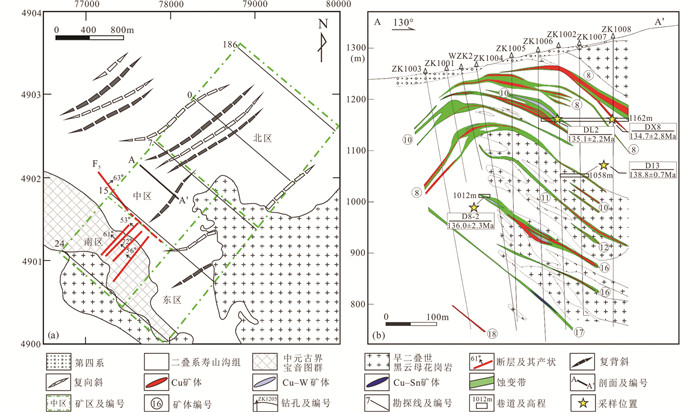
|
图 2 道伦达坝矿床地质图(a)和A-A′勘探线剖面图(b)(据陈公正等, 2018b修改) Fig. 2 Geoglogical map (a) and geological cross-section along the exploration line A-A′ (b) of the Daolundaba deposit (modified after Chen et al., 2018b) |
道伦达坝矿床主要矿石矿物为黄铜矿、黑钨矿、锡石、磁黄铁矿、黄铁矿和毒砂(图 3a-d, f-h),其次是黝锡矿、闪锌矿、白钨矿及少量自然银、辉银矿和自然铋;脉石矿物以石英和萤石为主(图 3a, b, d, g, h),亦有少量方解石、白云母、绢云母、电气石、独居石、磷灰石(图 3e, h, i)。黑钨矿呈团块状、粒状产于萤石和蚀变砂板岩中,形成钨矿石、铜钨矿石(图 3a, c),与黄铜矿、毒砂、磁黄铁矿一起构成铜钨矿石(图 3d);锡石多呈他形粒状结构,黝锡矿多呈环带状包裹锡石(图 3b);毒砂常具自形-半自形粒状结构(图 3b)及压碎结构(图 3d);黄铜矿、磁黄铁矿及闪锌矿常呈他形粒状结构(图 3d, g)。矿石常见浸染状、细脉浸染状构造(图 3a, c)和角砾状构造(图 3f),亦见少量的团块状构造(图 3i)。道伦达坝矿床围岩蚀变较为发育,蚀变带沿矿脉两侧分布(图 2b),蚀变类型主要为硅化和萤石化(图 4a-e),及少量绢云母化、白云母化(图 4f-h)、碳酸盐化(图 4i)、高岭土化和电气石化。其中,硅化和萤石化与矿化关系最为密切。绢云母化及白云母化常见于蚀变黑云母花岗岩中(图 4f-h),碳酸盐化见于IV阶段矿体的围岩中(图 4i)。
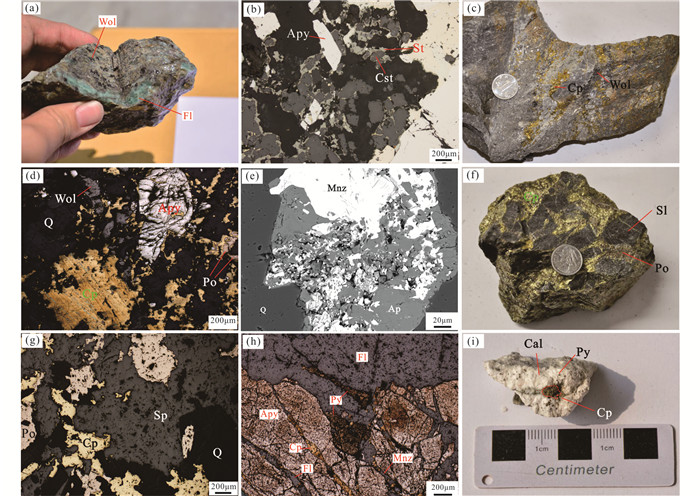
|
图 3 道伦达坝矿床典型矿石照片 (a)Ⅰ阶段钨矿石中的黑钨矿与萤石共生;(b)Ⅰ阶段锡矿石中黝锡矿生长于锡石外围,被Ⅱ阶段的毒砂穿插;(c)Ⅱ阶段铜钨矿石中的黑钨矿和黄铜矿;(d)Ⅱ阶段铜钨矿石中的黑钨矿、黄铜矿、磁黄铁矿、毒砂,毒砂呈压碎结构;(e)与Ⅱ阶段铜钨矿石共生的独居石和磷灰石(BSE图像);(f)Ⅲ阶段角砾状铜矿石;(g)Ⅲ阶段铜矿石中的黄铜矿、磁黄铁矿、闪锌矿;(h)Ⅲ阶段铜矿石中的黄铜矿、毒砂、黄铁矿、独居石和萤石;(i)Ⅳ阶段方解石脉,发育浸染状黄铁矿,并包含Ⅲ阶段的黄铜矿角砾. Ap-磷灰石;Apy-毒砂;Cal-方解石;Cp-黄铜矿;Cst-锡石;Fl-萤石;Mnz-独居石;Po-磁黄铁矿;Py-黄铁矿;Q-石英;Sl-板岩;Sp-闪锌矿;St-黝锡矿;Wol-黑钨矿 Fig. 3 Representative photos of ores in the Daolundaba deposit (a) coexisting wolframite and fluorite in W ores of the stage Ⅰ; (b) Sn ores of the stage Ⅰ, stannite growing around cassiterite, and cassiterite and stannite cut by arsenopyrite of the stage Ⅱ; (c) wolframite and chalcopyrite in Cu-W ores of the stage Ⅱ; (d) wolframite, chalcopyrite, pyrrhotite, and arsenopyrite in Cu-W ores of the stage Ⅱ, and arsenopyrite developing a crushing texture; (e) monazite and apatite (BSE) associated with Cu-W ores of the stage Ⅱ; (f) breccia Cu ores of the stage Ⅲ, broken slate breccia cemented by chalcopyrite and pyrrhotite; (g) chalcopyrite, pyrrhotite, and sphalerite in Cu ores of the stage Ⅱ; (h) coexisting chalcopyrite, arsenopyrite, pyrite, monazite, and fluorite in Cu ores of the stage Ⅱ; (i) calcite vein of the stage Ⅳ with disseminated pyrite, and containing Cu mineralized slate breccia of the stage Ⅲ. Ap-apatite; Apy-arsenopyrite; Cal-calcite; Cp-chalcopyrite; Cst-cassiterite; Fl-fluorite; Mnz-monazite; Po-pyrrhotite; Py-pyrite; Q-quartz; Sl-slate; Sp-sphalerite; St-stannite; Wol-wolframite |
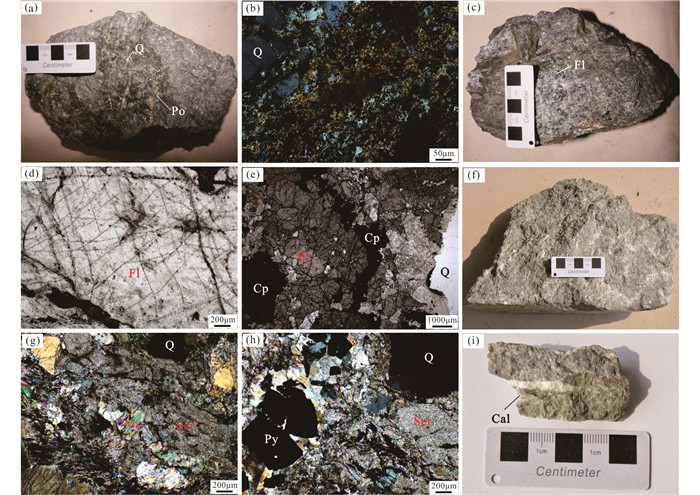
|
图 4 道伦达坝矿床围岩蚀变典型照片 (a、b)硅化板岩;(c-e)萤石化蚀变岩;(f-h)黄铁绢英岩化黑云母花岗岩;(i)碳酸盐化及碳酸盐脉. Ms-白云母;Ser-绢云母 Fig. 4 Representative photos of wall-rock alteration in the Daolundaba deposit (a, b) silicified slate; (c-e) fluoritized altered rocks; (f-h) biotite granite with silicification, sericitization, and pyritization; (i) carbonatization and calcite vein. Ms-muscovite; Ser-sericite |
结合野外观察和室内光薄片鉴定结果,将道伦达坝矿床的成矿过程划分为4个阶段:(1)石英-萤石-白云母-电气石-锡石-黑钨矿阶段(Ⅰ阶段),该阶段以锡石和黑钨矿的出现为特征,是锡矿化的主要阶段,金属矿物以锡石为主,黑钨矿次之,亦有少量黝锡矿、白钨矿和毒砂,脉石矿物以石英为主,含少量萤石,亦可见白云母和电气石;(2)石英-萤石-黑钨矿-黄铜矿-毒砂-磁黄铁矿阶段(Ⅱ阶段),该阶段为钨矿化的主要阶段,以大量黑钨矿和黄铜矿的共存为特征,亦有少量毒砂、磁黄铁矿,另可见少量白钨矿、铁闪锌矿和黝锡矿,脉石矿物以石英和萤石为主;(3)石英-萤石-黄铜矿-黄铁矿-磁黄铁矿-银矿物阶段(Ⅲ阶段),该阶段以黄铜矿的大量发育和黑钨矿的消失为特征,为铜矿化的主要阶段,该阶段金属矿物主要为黄铜矿、黄铁矿和磁黄铁矿,亦有少量黝铜矿、闪锌矿、辉银矿等,脉石矿物以石英和萤石为主;(4)方解石-萤石-黄铁矿阶段(Ⅳ阶段),该阶段含矿性差,不构成工业矿体。
3 样品和分析方法本次采集1件细粒花岗岩样品(DW3-9)用于LA-ICP-MS锆石U-Pb定年。采样点位于张家营子岩体西部(图 1c)。岩石风化面呈黄褐色,新鲜面为浅黄白色,具细粒花岗结构(图 5)。采集3件矿石样品(DL2、D8-2和DX8)用于LA-ICP-MS独居石U-Pb定年。其中样品DL2采自1162中段10号铜钨矿体(图 2b),为铜钨矿石(图 3c);样品D8-2采自1012中段16号铜钨矿体(图 2b),亦为铜钨矿石(图 3d);样品DX8采自1162m中段8号铜矿体(图 2b),为铜矿石(图 3g, h)。除了独居石,铜钨矿石中还可见磷灰石(图 3e)。用于绢云母40Ar-39Ar定年的样品D13采自1058m中段8号铜矿体附近的蚀变带(图 2b),为黄铁绢英岩化黑云母花岗岩(图 4f-h)。

|
图 5 张家营子岩体细粒花岗岩照片 Kf-钾长石 Fig. 5 Representative photo and microphoto of fine-grained granite from the Zhangjiayingzi intrusion Kf-potash feldspar |
锆石在河北省廊坊区域地质调查院进行分选,先将样品进行粗碎,然后采用重力和磁选方法分选,将粉碎后的样品分粒级进行淘洗,并在双目镜下挑选出锆石。锆石制靶和照相在北京锆年领航科技有限公司进行,将锆石置于环氧树脂中,磨制约一半大小,使锆石内部暴露,并进行阴极发光(CL)、透射光和反射光拍照。锆石U-Pb分析在北京科荟测试技术有限公司利用激光烧蚀多接收等离子体质谱仪(LA-ICP-MS)完成,采用美国ESI公司生产的NEW WAVE 193nm FX ArF准分子激光器搭配一台美国Thermo Fisher公司生产的NEPUNE PLUS。测试过程中,激光剥蚀束斑直径为30μm,频率为10Hz,能量密度约为2.5J/cm2,并以氦气作为剥蚀物质载气。使用ICPMSdatacal进行数据的处理与年龄计算(Liu et al., 2010),用Isoplot 3.0程序绘制锆石年龄谐和图以及直方图(Ludwig, 2003)。单个点的分析误差是1σ水平,整体年龄误差在2σ水平上是95%。
3.2 LA-ICP-MS独居石U-Pb定年独居石在河北省廊坊市地科勘探有限责任公司进行挑选,先将样品进行粗碎,然后采用重力和磁选方法分选,将粉碎后的样品分粒级进行淘洗,并在双目镜下挑选出独居石。独居石制靶及背散射电子(BSE)图像拍照在北京锆年领航科技有限公司进行。LA-ICP-MS独居石U-Pb分析在北京科荟测试技术有限公司完成,测试仪器为美国ESI公司生产的NEW WAVE 193nm FX ArF准分子激光器搭配一台美国Thermo Fisher公司生产的NEPUNE PLUS。测试的激光束斑直径为20μm,频率为5Hz,测试时选择晶形较好、裂隙和包裹体发育较少的颗粒以降低普通铅的影响。使用ICPMSdatacal进行数据的处理与年龄计算(Liu et al., 2010),用Isoplot 3.0程序绘制独居石年龄谐和图以及直方图(Ludwig, 2003)。单个点的分析误差是1σ水平,整体年龄误差在2σ水平上是95%。
3.3 绢云母40Ar-39Ar定年绢云母挑选在廊坊诚信地质服务公司完成,绢云母较为细小,难以挑选出纯净的绢云母,因此本次采用反选的方法,将样品粉碎后挑选出金属硫化物及石英等矿物,剩余样品即为纯净的绢云母。40Ar-39Ar同位素定年在核工业北京地质研究院进行。被分析的绢云母样品经过选纯(纯度>99%)和超声波清洗。清洗后的样品被封进石英瓶中送核反应堆接受中子照射,样品照射在中国原子能科学研究院的“游泳池堆”中进行,使用H8孔道,中子流密度约为6.0×1012n/cm2·S,照射总时间为3064分钟,积分中子通量为1.10×1018n/cm2。同期接受中子照射的还有用作监控样的标准样ZBH-25黑云母国内标样,其标准年龄为132.7Ma,K含量为7.6%。样品的阶段升温加热使用电子轰击炉,每一个阶段加热30分钟,净化30分钟。质谱分析是在MM-1200B质谱计上进行的,每个峰值均采集8组数据。所有的数据在回归到时间零点值后再进行质量歧视校正、大气氩校正、空白校正和干扰元素同位素校正。系统空白水平:m/e=40、39、37、36分别小于6×10-15mol、4×10-16mol、8×10-17mol和2×10-17mol。中子照射过程中所产生的干扰同位素校正系数通过分析照射过的K2SO4和CaF2来获得,其值为:(36Ar/37Ar0)Ca=0.0002389;(40Ar/39Ar)K=0.004782;(39Ar/37Ar0)Ca=0.000806。37Ar经过放射性衰变校正,40K衰变常数=5.543×10-10a-1,坪年龄误差以2σ给出。用ISOPLOT程序计算正、反等时线(Ludwig, 2003)。详细实验流程见陈文等(2006)。
4 测试结果 4.1 LA-ICP-MS锆石U-Pb定年张家营子岩体细粒花岗岩样品DW3-9中的19粒锆石U-Pb分析点位和CL图像见图 6,其分析结果见表 1。
|
|
表 1 张家营子岩体细粒花岗岩(DW3-9)LA-ICP-MS锆石U-Pb分析结果 Table 1 LA-ICP-MS zircon U-Pb data for the fine-grained granite (Sample DW3-9) from the Zhangjiayingzi intrusion |
该样品中的锆石呈无色-浅黄色。锆石阴极发光图像显示,绝大多数锆石的晶体形态较好,主要呈单锥或双锥状,多数锆石具生长韵律环带(图 6),表明其为岩浆成因。19粒锆石的Th和U含量分别介于186×10-6~944×10-6和283×10-6~1358×10-6,Th/U比值介于0.48~0.83之间,亦表明其为岩浆成因(Pupin, 1980)。其206Pb/238U年龄的加权平均值为136.1±0.4Ma(MSWD=1.20;图 7),表明张家营子岩体形成于约136Ma。
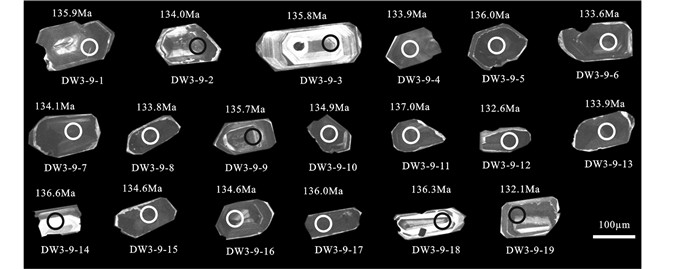
|
图 6 张家营子岩体细粒花岗岩锆石阴极发光图 Fig. 6 Representative cathodoluminescence (CL) images of zircon crystals from fine-grained granite of the Zhangjiayingzi intrusion, showing U-Pb analytical spots and corresponding ages |
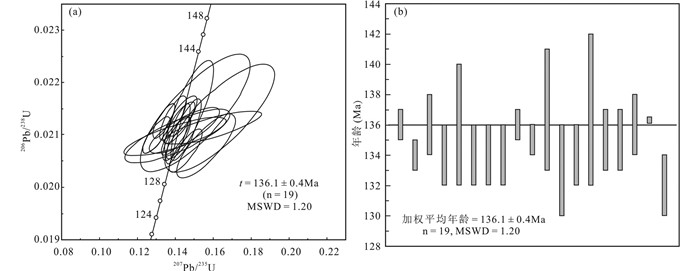
|
图 7 张家营子岩体细粒花岗岩锆石U-Pb年龄谐和图(a)及加权平均年龄(b) Fig. 7 Zircon U-Pb concordia diagram (a) and age histogram (b) for the fine-grained granite of the Zhangjiayingzi intrusion |
独居石样品DX8、DL2和D8-2的U-Pb分析点位和BSE图像见图 8,测试结果见表 2。
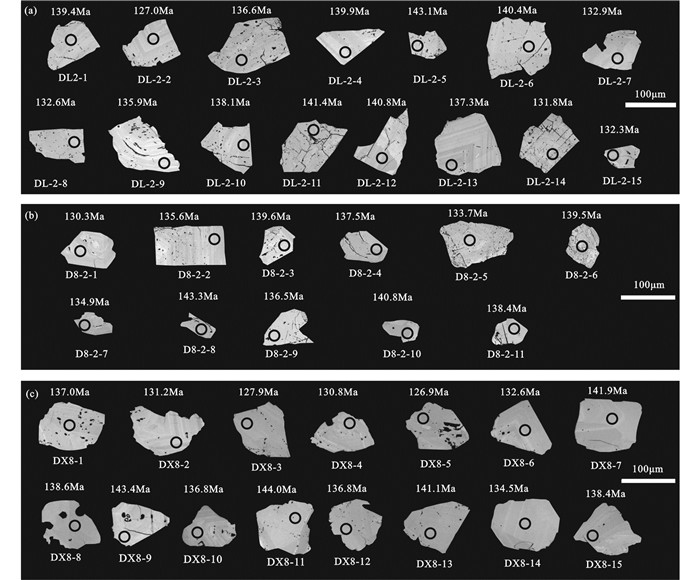
|
图 8 道伦达坝矿床独居石背散射图 Fig. 8 Representative backscattered electron (BSE) images of monazite crystals from the Daolundaba deposit, showing U-Pb analytical spots and corresponding ages |
|
|
表 2 道伦达坝矿床LA-ICP-MS独居石U-Pb定年数据(样品DL2、D8-2和DX8) Table 2 LA-ICP-MS monazite U-Pb dating data of the Daolundaba deposit (samples DL-2, D8-2 and DX8) |
道伦达坝矿床矿石中的独居石多呈不规则粒状,长30~200μm,富含Th(2304×10-6~119436×10-6)和U(966×10-6~21109×10-6),Pb含量相对较低(48×10-6~30968×10-6)。样品DL2中15粒独居石的206Pb/238U年龄的加权平均值为136.0±2.3Ma(MSWD=1.4;图 9a, b);样品D8-2中11粒独居石的206Pb/238U年龄加权平均值为135.1±2.2Ma(MSWD=1.1;图 9c, d);样品DX8中15粒独居石的206Pb/238U年龄加权平均值为134.7±2.8Ma(MSWD=1.4;图 9e, f)。综上,道伦达坝矿床铜钨矿体和铜矿体形成于134.7~136.0Ma。
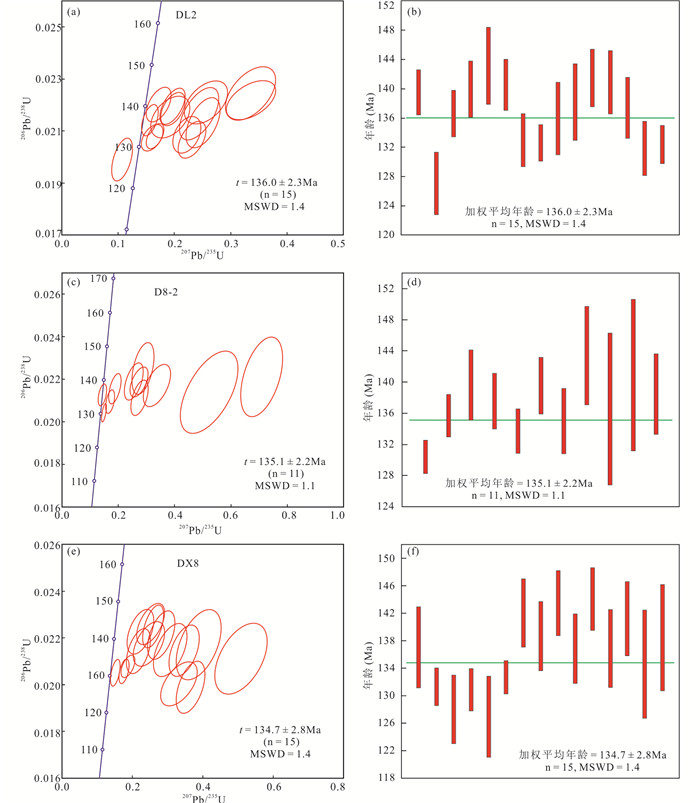
|
图 9 道伦达坝矿床独居石U-Pb年龄谐和图(a、c、e)及加权平均年龄(b、d、f) Fig. 9 Monazite U-Pb concordia diagrams (a, c, e) and age histograms (b, d, f) of the Daolundaba deposit |
道伦达坝矿床绢云母样品D13的10个阶段的加热分析结果列于表 3。总气体年龄为140.4±0.6Ma,其中800~1000℃的5个温度阶段组成了一个平坦的年龄坪,坪年龄为138.8±0.7Ma(MSWD=3.0),对应了71.45%的39Ar析出量(图 10a),相应的39Ar/36Ar-40Ar/39Ar等时线年龄为140.0±1.1Ma (MSWD=2.5,图 10b)。40Ar/36Ar初始比值为234±45,低于现代大气氩比值(295.5;Nier, 1950),表明其发生了微量放射性氩丢失,等时线年龄更接近绢云母的形成年龄。鉴于本次获得的绢云母坪年龄与等时线年龄在误差范围内基本一致,因此道伦达坝矿床第三成矿阶段的铜矿体形成于138.8~140.0Ma之间。
|
|
表 3 道伦达坝矿床蚀变矿物绢云母样品(样品D13)40Ar-39Ar阶段升温加热分析数据 Table 3 40Ar-39Ar stepwise heating data for sericite (Sample D13) from the Daolundaba deposit |
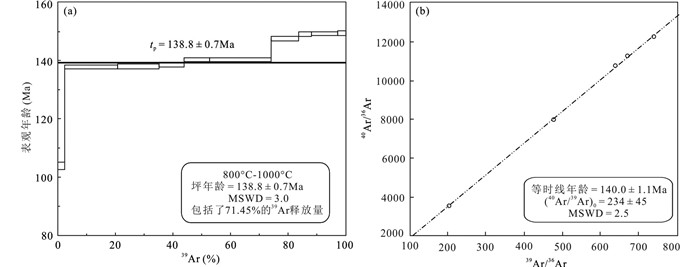
|
图 10 道伦达坝矿床绢云母40Ar-39Ar坪年龄(a)和等时线年龄(b) Fig. 10 Sericite 40Ar-39Ar plateau age (a) and isochron age (b) of the Daolundaba deposit |
道伦达坝地区主要发育前进场岩体和张家营子岩体。徐佳佳等(2012)报道了273~278Ma的前进场岩体黑云母花岗岩的LA-ICP-MS锆石U-Pb年龄;周振华等(2014)报道了292~293Ma的前进场岩体黑云母花岗岩的LA-ICP-MS锆石U-Pb年龄。道伦达坝矿床的矿体赋存于二叠系寿山沟组地层和华力西晚期前进场岩体内的构造破碎带中,前进场岩体与矿体空间上的紧密关系加之精确定年方法的缺乏使前人多认为道伦达坝矿床成矿与该岩体有关(徐佳佳等, 2012; 周振华等, 2014),并根据前进场岩体的形成时代认为道伦达坝矿床亦形成于华力西期(徐佳佳等, 2009, 2012; 周振华等, 2014; 张雪冰, 2017)。前人对成矿时代进行了研究,但争议较大:Feng et al. (2017)对道伦达坝矿床中的黄铜矿和磁黄铁矿开展了Rb-Sr测年,获得5件黄铜矿和5件磁黄铁矿的等时线年龄在282.7~283.0Ma之间,与前进场岩体形成时代基本一致,并据此认为前进场岩体为道伦达坝矿床成矿岩体;陈公正等(2018a)对道伦达坝矿床第一成矿阶段锡矿体中的锡石开展了LA-ICP-MS U-Pb测年,获得了135~137Ma的年龄,并认为道伦达坝矿床形成于早白垩世;张雪冰等(2021)对道伦达坝锡矿体中的石英开展包裹体40Ar-39Ar定年,获得了140.6±2.2Ma的年龄;李岩等(2020)指出,道伦达坝矿床存在早白垩世的锡矿化事件,但铜钨矿化与前进场岩体有关,形成于华力西期。以往的研究表明,Rb-Sr同位素体系容易被破坏,常受到假等时线的困扰(陈文等, 2011)。
本次测试获得张家营子岩体细粒花岗岩的锆石U-Pb年龄为136.1±0.4Ma;与铜钨矿体共生的2件独居石样品的U-Pb年龄分别为136.0±2.3Ma和135.1±2.2Ma;与铜矿体共生的1件独居石样品的U-Pb年龄为134.7±2.8Ma;与铜矿体关系密切的1件蚀变绢云母样品的40Ar-39Ar年龄为138.8~140.0Ma。野外考察发现,道伦达坝矿床虽然空间上与前进场岩体相近,但是矿体两侧的黑云母花岗岩均发生了强烈蚀变,蚀变带沿矿体呈明显的带状分布(图 2b),而远离矿体的岩石面貌新鲜。Yuan et al. (2018)对华南W-Sn矿床研究表明,在很多情况下,赋矿岩体与成矿并无关联,真正的成矿岩体可能隐伏于深部或出露于矿区外围。这些事实暗示前进场岩体更可能作为赋矿围岩存在,而非成矿岩体。此外,前人对道伦达坝矿床的硫化物开展了Pb同位素测试,硫化物Pb同位素组成与中生代岩体一致,明显不同于该地区的晚古生代岩体的Pb同位素组成,亦表明道伦达坝矿床与前进场岩体并无成因联系(陈公正等, 2018b)。综上,我们认为道伦达坝矿床的铜钨矿体、铜矿体均形成于早白垩世,该矿床的铜钨锡矿化属于同一个成矿系统,成矿与早白垩世花岗质岩浆活动有密切的成因关系。
大兴安岭南段发育的锡多金属矿床多呈NE向沿米生庙复背斜分布,矿床聚集区域大面积出露晚古生代地层及华力西期岩体,赋矿围岩常为前中生代地质体,但已有的研究表明几乎所有的锡多金属矿床均形成于晚侏罗世-早白垩世,特别是早白垩世。如:维拉斯托矿床的矿体赋存在中元古界宝音图群和石炭纪石英闪长岩中,但其LA-ICP-MS锡石U-Pb年龄为136.6±6Ma(刘瑞麟, 2018);白音查干东山矿床主要产于二叠系大石寨组地层中,但其LA-ICP-MS锡石U-Pb年龄为134±15Ma(李睿华, 2019);拜仁达坝矿床的赋矿围岩为中元古界宝音图群,但其成矿相关的绢云母和白云母40Ar-39Ar年龄分别为133.5Ma(刘翼飞, 2009)和135Ma(常勇和赖勇, 2010)。矿床及侵入岩可以作为地球动力学演化的标志(Mao et al., 2021),大兴安岭南段侵入岩和锡多金属矿床的形成年龄见表 4和图 11。表 4和图 11显示,侵入岩主要形成于4个时期:晚石炭世、早二叠世、早-中三叠世和晚侏罗世-早白垩世,尤以早白垩世岩浆活动最强烈(图 11a),这4个时期分别对应了古亚洲洋的俯冲、贺根山洋的闭合、古亚洲洋的闭合(Lu et al., 2020)和古太平洋板块的俯冲后撤或俯冲角度变化(Wu et al., 2002; Liu et al., 2005; Wang et al., 2012)。锡多金属矿床的成矿时代集中于130~150Ma之间,且以早白垩世为主(图 11b)。我们本次研究结果和前人获得的成岩成矿年龄表明,虽然大兴安岭南段存在多期岩浆活动,但锡多金属矿床集中形成于早白垩世,成矿与晚侏罗世-早白垩世,特别是早白垩世的花岗质岩浆活动有关。
|
|
表 4 大兴安岭南段主要锡多金属矿床成岩成矿时代 Table 4 Ages of major Sn-polymetallic deposits and ore-related intrusions in the southern Great Xing'an Range |
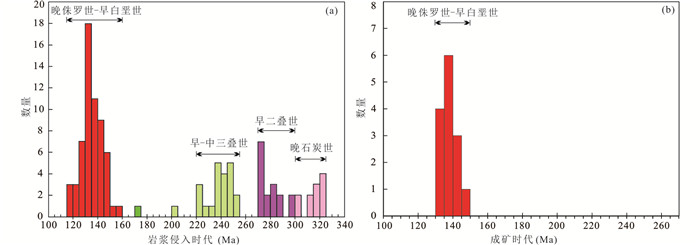
|
图 11 大兴安岭南段岩浆侵入时代(a)和主要的锡多金属矿床成矿时代(b)直方图 侵入岩年龄数据王国政(1997)、王一先和赵振华(1997)、Shi et al. (2004)、葛文春等(2005)、Zhu et al. (2006)、鲍庆中等(2007)、刘翼飞(2009)、刘建峰等(2009)、薛怀民等(2010)、张晓静等(2010)、周振华等(2010)、江思宏等(2011a,江思宏2011b)、Wu et al.(2011a, b)、郭志军等(2012)、Zhou et al. (2012)、Ma et al. (2013)、阮班晓等(2013)、Shu et al.(2013a, b)、许文良等(2013)、Zhai et al. (2014)、Ruan et al. (2015)、王承洋(2015)、顾玉超等(2017)、Zhai et al. (2017)、刘瑞麟(2018)、Liu et al. (2018)、李睿华(2019)、Mi et al. (2020)及本文.成矿年龄数据艾永富和张晓辉(1996)、Ishiyama et al. (2001)、王国政(2002)、刘翼飞(2009)、潘小菲等(2009)、常勇和赖勇(2010)、周振华等(2010)、翟德高等(2012)、王明艳和何玲(2013)、廖震等(2014)、万多等(2014)、王承洋(2015)、Zhai et al. (2017)、陈公正等(2018a)、刘瑞麟(2018)、刘瑞麟等(2018)、Liu et al. (2018)、李睿华(2019)、Wang et al. (2019a)及本文 Fig. 11 Age histograms for intrusions (a) and major Sn-polymetallic ore deposits (b) in the southern Great Xing'an Range |
张家营子岩体具有高硅(73.73%~76.61%)、富碱(6.96%~8.6%),贫铁、镁、钙的特征,微量元素以富集Rb、Th、U、K,强烈亏损Ba、Sr、P、Eu和Ti等元素为特征,稀土总量低,Eu负异常强(0.01~0.25),轻重稀土分馏不明显,稀土配分曲线呈“海鸥”式,具有明显的稀土元素四分组效应(陈公正, 2018)。前进场岩体中SiO2含量为65.42%~67.41%,CaO含量在1.35%~2.22%之间,TiO2含量在0.55%~0.70%,Mg#值为36~44,稀土配分曲线呈右倾式,具有中等Eu负异常(周振华等, 2014)。相比于张家营子岩体,前进场岩体具有贫硅、高CaO和TiO2含量和高Mg#值的特点。地球化学特征表明张家营子岩体为高分异花岗岩,而前进场岩体的分异程度较低。
尽管对与锡多金属矿床成矿相关的岩体成因类型仍有不同认识(Blevin and Chappell, 1995; Romer and Kroner, 2015, 2016; Zhao et al., 2018),但是多数研究者认为花岗质岩浆的结晶分异在锡多金属矿床形成过程中起着重要的作用(Lehmann, 1990; Singh and Singh, 2001; Neiva, 2002; Breiter, 2012; Fogliata et al., 2012; Teixeira et al., 2012; Yuan et al., 2018)。在大兴安岭南段,白音查干东山超大型Sn-Ag多金属矿床与高分异的含电气石花岗斑岩和花岗斑岩有关(李睿华, 2019);维拉斯托大型稀有金属-锡多金属矿床成矿与高分异的斑状细粒碱长花岗岩有关(刘瑞麟等, 2018)。在华南地区,许多锡钨多金属矿床的成矿岩体亦为高分异花岗岩,如个旧大型锡多金属矿床(Cheng and Mao, 2010; Cheng et al., 2013)、大厂大型锡多金属矿床(Wang et al., 2019b)、以及西华山和大湖塘钨矿床(Guo et al., 2012; Yang et al., 2013; Huang and Jiang, 2014; Mao et al., 2015)。泰国北部的Sn-W成矿作用被认为与高分异的昆坦岩基有关(Yokart et al., 2003);欧洲厄尔士山脉中部和葡萄牙北部的锡钨矿床(Neiva, 2002; Breiter, 2012)、印度巴尔达地区的钨矿床(Singh and Singh, 2001)成因都与高分异花岗岩有关。张家营子岩体属于高分异花岗岩,且成岩年龄与道伦大坝矿床的成矿年龄在误差范围内一致,暗示其可能与该矿床的成矿作用有成因联系。但目前出露的张家营子岩体距道伦大坝矿床约10km,前人的研究表明锡多金属矿床的成矿岩体常隐伏于矿床的深部(陈公正, 2018; 刘瑞麟, 2018; Yuan et al., 2018),因此,我们推断,道伦达坝矿床真正的成矿岩体仍然隐伏在道伦达坝矿床深部,其与张家营子岩体具有相同的成岩时代和相似的地球化学特征。
道伦达坝矿床各成矿阶段均发育萤石,且流体包裹体研究显示道伦达坝矿床前3阶段发育大量含子矿物包裹体(陈公正等, 2018b),暗示花岗质岩浆和成矿流体具有富F和Cl的特征。研究表明,熔体中较高的F含量可以增加熔体中的非桥氧的数量,破坏熔体结构,降低熔体粘度及熔体固相线温度,有利于岩浆发生分离结晶作用(Schaller et al., 1992; Audťat et al., 2000; Mysen et al., 2004)。当岩浆达到水饱和时,流体从岩浆中出溶。F具有强烈的亲熔体性,因此,热液中F浓度的增加对W、Sn的流体/熔体分配系数影响不大,但F的存在可以使W、Sn进一步汇聚于岩浆晚期,为热液型W、Sn矿床的最终形成提供了丰富的物质来源(Keppler and Wyllie, 1991; Bhalla et al., 2005; Hu et al., 2009; Yuan et al., 2019; 袁顺达等, 2020)。在熔体-流体共存体系中,Cl的流体/熔体分配系数较大(10~100),因此Cl在岩浆分异过程中大量进入流体相。在一般的岩浆体系中,W、Sn的流体/熔体分配系数较低(明显小于1),岩浆分离结晶过程中W、Sn优先进入花岗质熔体中,但随着Cl浓度的增加,W和Sn的流体/熔体分配系数显著提高,W和Sn进入流体相,形成富含W和Sn的成矿流体(Webster and Holloway, 1988; Keppler and Wyllie, 1991; Audťat et al., 2000; Signorelli and Carroll, 2000; Zajacz et al., 2008; Hu et al., 2009; 袁顺达和赵盼捞, 2020)。Cu的流体/熔体分配系数高,优先进入流体相;在高温的天然体系中Cu也表现出强烈的亲卤水性,因此,Cl浓度的增加,会大大增加Cu在流体/熔体间的分配系数(Simon et al., 2005; Pokrovski et al., 2013)。
综上,富F、Cl等挥发分的高分异花岗岩对Sn、W的成矿有重要意义,暗示道伦达坝矿床的成矿作用与早白垩世高分异花岗岩有密切的成因联系。
6 结论(1) 道伦达坝地区的张家营子岩体LA-ICP-MS锆石U-Pb年龄为136.1±0.4Ma,为早白垩世岩浆活动的产物。
(2) 道伦达坝矿床LA-ICP-MS独居石U-Pb年龄为134.7~136.0Ma,绢云母40Ar-39Ar年龄为138.8~140.0Ma,表明道伦达坝矿床铜钨矿化和铜矿化均形成于早白垩世。
(3) 道伦达坝铜钨锡矿床的成矿作用与矿区内隐伏的早白垩世花岗岩有密切的成因联系,花岗质岩浆的分离结晶在道伦达坝矿床的形成过程中起到了重要作用。
致谢 野外工作得到了内蒙古银鑫矿业有限公司各级领导的大力支持;内蒙古自治区地质调查院张彤、章培春、李雪娇、赵静、闫洁、张婷婷和魏雅玲参加了部分野外工作;二位审稿人提出了宝贵的修改意见。在此一并致以诚挚的感谢。
Ai YF and Zhang XH. 1996. Dykes and mineralization in Dajing mine, Inner Mongolia. In: Geological Society of China (ed. ). Thesis of Important Achievements of National Geological Science and Technology in the 8th-5-Year-Plan. Beijing: Metallurgical Industry Press, 231-234 (in Chinese)
|
Audťat A,  D and Heinrich CA. 2000. Magmatic-hydrothermal evolution in a fractionating granite: A microchemical study of the Sn-W-F-mineralized Mole granite (Australia). Geochimica et Cosmochimica Acta, 64(19): 3373-3393 DOI:10.1016/S0016-7037(00)00428-2 D and Heinrich CA. 2000. Magmatic-hydrothermal evolution in a fractionating granite: A microchemical study of the Sn-W-F-mineralized Mole granite (Australia). Geochimica et Cosmochimica Acta, 64(19): 3373-3393 DOI:10.1016/S0016-7037(00)00428-2
|
Bao QZ, Zhang CJ, Wu ZL, Wang H, Li W, Sang JH and Liu YS. 2007. SHRIMP U-Pb zircon geochronology of a Carboniferous quartz-diorite in Baiyingaole area, Inner Mongolia and its implications. Journal of Jilin University (Earth Science Edition), 37(1): 15-23 (in Chinese with English abstract)
|
Bhalla P, Holtz F, Linnen RL and Behrens H. 2005. Solubility of cassiterite in evolved granitic melts: Effect of T, fO2, and additional volatiles. Lithos, 80(1-4): 387-400 DOI:10.1016/j.lithos.2004.06.014
|
Blevin PL and Chappell BW. 1995. Chemistry, origin, and evolution of mineralized granites in the Lachlan fold belt, Australia: The metallogeny of I- and S-type granites. Economic Geology, 90(6): 1604-1619 DOI:10.2113/gsecongeo.90.6.1604
|
Breiter K. 2012. Nearly contemporaneous evolution of the A- and S-type fractionated granites in the Krušné hory/Erzgebirge Mts. , Central Europe. Lithos, 151: 105-121
|
Bureau of Geology and Mineral Resources of Inner Mongolian Autonomous Region. 1991. Regional Geology of Inner Mongolian Autonomous Region. Beijing: Geological Publishing House, 1-498 (in Chinese)
|
Chang Y and Lai Y. 2010. Study on characteristics of ore-forming fluid and chronology in the Yindu Ag-Pb-Zn polymetallic ore deposit, Inner Mongolia. Acta Scientiarum Naturalium Universitatis Pekinensis, 46(4): 581-593 (in Chinese with English abstract)
|
Chen B, Jahn BM and Tian W. 2009. Evolution of the Solonker suture zone: Constraints from zircon U-Pb ages, Hf isotopic ratios and whole-rock Nd-Sr isotope compositions of subduction- and collision-related magmas and forearc sediments. Journal of Asian Earth Sciences, 34(3): 245-257 DOI:10.1016/j.jseaes.2008.05.007
|
Chen GZ. 2018. Metallogenesis of the Daolundaba Cu-polymetallic deposit in the southern Graet Xing'an Range. Master Degree Thesis. Beijing: China University of Geosciences (Beijing), 1-131 (in Chinese with English summary)
|
Chen GZ, Wu G, Li TG, Liu RL, Wu LW, Zhang PC, Zhang T and Chen YC. 2018a. LA-ICP-MS zircon and cassiterite U-Pb ages of Daolundaba copper-tungsten-tin deposit in Inner Mongolia and their geological significance. Mineral Deposits, 37(2): 225-245 (in Chinese with English abstract)
|
Chen GZ, Wu G, Wu WH, Zhang T, Li TG, Liu RL, Wu LW, Zhang PC, Jiang B and Wang ZL. 2018b. Fluid inclusion study and isotope characteristics of the Daolundaba copper-polymetallic deposit in the southern Great Xing'an Range. Earth Science Frontiers, 25(5): 202-221 (in Chinese with English abstract)
|
Chen W, Zhang Y, Zhao HB, Han D and Wang CY. 2006. Mineralization age of the Hongshan gold deposit, East Tianshan, Xinjiang. Geology in China, 33(3): 632-640 (in Chinese with English abstract)
|
Chen W, Wan YS, Li HQ, Zhang ZQ, Dai TM, Shi ZE and Sun JB. 2011. Isotope geochronology: Technique and application. Acta Geologica Sinica, 85(11): 1917-1947 (in Chinese with English abstract)
|
Cheng YB and Mao JW. 2010. Age and geochemistry of granites in Gejiu area, Yunnan Province, SW China: Constraints on their petrogenesis and tectonic setting. Lithos, 120(3-4): 258-276 DOI:10.1016/j.lithos.2010.08.013
|
Cheng YB, Mao JW, Chang ZS and Pirajno F. 2013. The origin of the world class tin-polymetallic deposits in the Gejiu district, SW China: Constraints from metal zoning characteristics and 40Ar-39Ar geochronology. Ore Geology Reviews, 53: 50-62 DOI:10.1016/j.oregeorev.2012.12.008
|
Cogné JP, Kravchinsky VA, Halim N and Hankard F. 2005. Late Jurassic-Early Cretaceous closure of the Mongol-Okhotsk Ocean demonstrated by new Mesozoic palaeomagnetic results from the Trans-Baïkal area (SE Siberia). Geophysical Journal International, 163(2): 813-832 DOI:10.1111/j.1365-246X.2005.02782.x
|
Dong JY. 2014. Characteristics and geological significance of ophiolite on the area Daqingmuchang in Xiwuqi, Inner Mongolia. Master Degree Thesis. Beijing: China University of Geosciences (Beijing), 1-49 (in Chinese with English summary)
|
Duan M, Zeng W, Feng XX, Wei JL, Zhang F, Xie Y, Gao ZR, Qu K and Liu XX. 2016. LA-ICP-MS zircon U-Pb ages and geological features of Daolundaba granite in Xilinhaote area, Inner Mongolia. Geological Bulletin of China, 35(7): 1207-1216 (in Chinese with English abstract)
|
Feng JR, Zhou ZH and Che HW. 2017. Permian copper-polymetallic mineralization in the southern Great Xing'an Range, Northeast China: The Daolundaba copper-polymetallic deposit example. International Geology Review, 59(13): 1709-1722 DOI:10.1080/00206814.2017.1294508
|
Fogliata AS, Báez MA, Hagemann SG, Santos JO and Sardi F. 2012. Post-orogenic, Carboniferous granite-hosted Sn-W mineralization in the Sierras Pampeanas Orogen, Northwestern Argentina. Ore Geology Reviews, 45: 16-32 DOI:10.1016/j.oregeorev.2011.12.001
|
Ge MC, Zhou WX, Yu Y, Sun JJ, Bao JQ and Wang SH. 2011. Dissolution and supracrustal rocks dating of Xilin Gol Complex, Inner Mongolia, China. Earth Science Frontiers, 18(5): 182-195 (in Chinese with English abstract)
|
Ge WC, Wu FY, Zhou CY and Zhang JH. 2005. Zircon U-Pb ages and its significance of the Mesozoic granites in the Wulanhaote region, central Da Hinggan Mountain. Acta Petrologica Sinica, 21(3): 749-762 (in Chinese with English abstract)
|
Ge WC, Wu FY, Zhou CY and Zhang JH. 2007. Porphyry Cu-Mo deposits in the eastern Xing'an-Mongolian Orogenic Belt: Mineralization ages and their geodynamic implications. Chinese Science Bulletin, 52(24): 3416-3427 DOI:10.1007/s11434-007-0466-8
|
Gu YC, Chen RY, Jia B and Ju N. 2017. Zircon U-Pb dating and geochemistry of the granite porphyry from the Shuangjianzishan silver polymetallic deposit in Inner Mongolia and tectonic implications. Geology and Exploration, 53(3): 495-507 (in Chinese with English abstract)
|
Guo CL, Chen YC, Zeng ZL and Lou FS. 2012. Petrogenesis of the Xihuashan granites in southeastern China: Constraints from geochemistry and in-situ analyses of zircon U-Pb-Hf-O isotopes. Lithos, 148: 209-227 DOI:10.1016/j.lithos.2012.06.014
|
Guo ZJ, Zhou ZH, Li GT, Li JW, Wu XL, Ouyang HG, Wang AS, Xiang AP and Dong XZ. 2012. SHRIMP U-Pb zircon dating and petrogeochemistral characteristics of the intermediate-acid intrusive rocks in the Aoergai copper deposit of Inner Mongolia. Geology in China, 39(6): 1486-1500 (in Chinese with English abstract)
|
Hu XY, Bi XW, Shang LB, Hu RZ, Cai GS and Chen YW. 2009. An experimental study of tin partition between melt and aqueous fluid in F/Cl-coexisting magma. Chinese Science Bulletin, 54(6): 1087-1097
|
Huang LC and Jiang SY. 2014. Highly fractionated S-type granites from the giant Dahutang tungsten deposit in Jiangnan Orogen, Southeast China: Geochronology, petrogenesis and their relationship with W-mineralization. Lithos, 202-203: 207-226 DOI:10.1016/j.lithos.2014.05.030
|
Ishiyama D, Sato R, Mizuta T, Ishikawa T and Wang JB. 2001. Characteristic features of tin-iron-copper mineralization in the Anle-Huanggangliang mining area, Inner Mongolia, China. Resource Geology, 51(4): 377-392 DOI:10.1111/j.1751-3928.2001.tb00109.x
|
Jian P, Kröner A, Windley BF, Shi YR, Zhang W, Zhang LQ and Yang WR. 2012. Carboniferous and Cretaceous mafic-ultramafic massifs in Inner Mongolia (China): A SHRIMP zircon and geochemical study of the previously presumed integral "Hegenshan ophiolite". Lithos, 142-143: 48-66 DOI:10.1016/j.lithos.2012.03.007
|
Jiang BB, Zhu XY, Huang XK, Zou T, Xu Q and Liu Z. 2020. Determination of metallogenic age and prospecting significance of the Baiyinnuoer lead-zinc deposit in the southern Da Hinggan Mountains. Acta Geologica Sinica, 94(10): 2844-2855 (in Chinese with English abstract)
|
Jiang HY, Zhao ZD, Zhu XY, Yang SS, Jiang BB, Yang CL and Mao CW. 2020. Characteristics and metallogenic significance of granite porphyry and pyroxene diorite in the Bianjiadayuan Pb-Zn-Ag polymetallic deposit, Inner Mongolia. Geology in China, 47(2): 450-471 (in Chinese with English abstract)
|
Jiang SH, Nie FJ, Bai DM, Niu SY, Wang BD, Liu YF and Liu Y. 2011a. Study on the lead isotopic features of the Baiyinnuoer Pb-Zn deposit in Inner Mongolia. Journal of Earth Sciences and Environment, 33(3): 230-236 (in Chinese with English abstract)
|
Jiang SH, Nie FJ, Bai DM, Liu YF and Liu Y. 2011b. Geochronology evidence for Indosinian mineralization in Baiyinnuoer Pb-Zn deposit of Inner Mongolia. Mineral Deposits, 30(5): 787-798 (in Chinese with English abstract)
|
Jiang SH, Chen CL, Bagas L, Liu Y, Han N, Kang H and Wang ZH. 2017. Two mineralization events in the Baiyinnuoer Zn-Pb deposit in Inner Mongolia, China: Evidence from field observations, S-Pb isotopic compositions and U-Pb zircon ages. Journal of Asian Earth Sciences, 144: 339-367 DOI:10.1016/j.jseaes.2016.12.042
|
Keppler H and Wyllie PJ. 1991. Partitioning of Cu, Sn, Mo, W, U, and Th between melt and aqueous fluid in the systems haplogranite-H2O-HCl and haplogranite-H2O-HF. Contributions to Mineralogy and Petrology, 109(2): 139-150 DOI:10.1007/BF00306474
|
Lehmann B. 1990. Metallogeny of Tin. Berlin, Heidelberg: Springer: 1-218
|
Li JY, Gao LM, Sun GH, Li YP and Wang YB. 2007. Shuangjingzi middle Triassic syn-collisional crust-derived granite in the east Inner Mongolia and its constraint on the timing of collision between Siberian and Sino-Korean paleo-plates. Acta Petrologica Sinica, 23(3): 565-582 (in Chinese with English abstract)
|
Li RH. 2019. Metallogenesis of tin-copper-polymetallic ore deposits in the Xilinhot area, the southern Great Xing'an Range, China. Ph. D. Dissertation. Beijing: Peking University, 1-239 (in Chinese with English summary)
|
Li Y, Xu LQ, Li TD, Xiao QH, Guo LJ, Cheng Y, Fan YX, Pang JL, Yuan WM and Luo PY. 2020. Geochronology, zircon trace element and Lu-Hf isotope characteristics of the biotite granite and their geological significance from Daolundaba Cu polymetallic deposit, southern Great Hinggan Ling, China. Earth Science, 45(7): 2585-2597 (in Chinese with English abstract)
|
Liao Z, Wang YW, Wang JB, Li HM and Long LL. 2014. In-situ LA-MC-ICP-MS U-Pb geochronology of cassiterite from Dajing tin-polymetallic deposits. Mineral Deposits, 33(Suppl.1): 421-422 (in Chinese)
|
Liu JF, Chi XG, Zhang XZ, Ma ZH, Zhao Z, Wang TF, Hu ZC and Zhao XY. 2009. Geochemical characteristic of Carboniferous quartz-diorite in the southern Xiwuqi area, Inner Mongolia and its tectonic significance. Acta Geologica Sinica, 83(3): 356-376 (in Chinese with English abstract)
|
Liu JM, Zhang R and Zhang QZ. 2004. The regional metallogeny of Da Hinggan Ling, China. Earth Science Frontiers, 11(1): 269-277 (in Chinese with English abstract)
|
Liu LJ, Zhou TF, Zhang DY, Yuan F, Liu GX, Zhao ZC, Sun JD and White N. 2018. S isotopic geochemistry, zircon and cassiterite U-Pb geochronology of the Haobugao Sn polymetallic deposit, southern Great Xing'an Range, NE China. Ore Geology Reviews, 93: 168-180 DOI:10.1016/j.oregeorev.2017.12.008
|
Liu RL. 2018. Metallogenesis of the Weilasituo rare metals-tin polymetallic metallogenic system in Inner Mongolia. Ph. D. Dissertation. Beijing: Peking University, 1-196 (in Chinese with English summary)
|
Liu RL, Wu G, Li TG, Chen GZ, Wu LW, Zhang PC, Zhang T, Jiang B and Liu WY. 2018. LA-ICP-MS cassiterite and zircon U-Pb ages of the Weilasituo tin-polymetallic deposit in the southern Great Xing'an Range and their geological significance. Earth Science Frontiers, 25(5): 183-201 (in Chinese with English abstract)
|
Liu W, Siebel W, Li XJ and Pan XF. 2005. Petrogenesis of the Linxi granitoids, northern Inner Mongolia of China: Constraints on basaltic underplating. Chemical Geology, 219(1-4): 5-35 DOI:10.1016/j.chemgeo.2005.01.013
|
Liu W, Pan XF, Xie LW and Li H. 2007. Sources of material for the Linxi granitoids, the southern segment of the Da Hinggan Mts. : When and how continental crust grew? Acta Petrologica Sinica, 23(2): 441-460 (in Chinese with English abstract)
|
Liu YF. 2009. Formation of Bairendaba silver polymetallic deposit in Keshiketeng Banner, Inner Mongolia. Master Degree Thesis. Beijing: Chinese Academy of Geological Sciences, 1-98 (in Chinese with English summary)
|
Liu YS, Gao S, Hu ZC, Zong KQ, Gao CG, Gao S, Xu J and Chen HH. 2010. Continental and oceanic crust recycling-induced melt-peridotite interactions in the Trans-North China Orogen: U-Pb dating, Hf isotopes and trace elements in zircons from mantle xenoliths. Journal of Petrology, 51(1-2): 537-571 DOI:10.1093/petrology/egp082
|
Lu L, Qin Y, Zhang KJ, Han CY, Wei T, Li ZF and Qu ZH. 2020. Provenance and tectonic settings of the late Paleozoic sandstones in central Inner Mongolia, NE China: Constraints on the evolution of the southeastern Central Asian Orogenic Belt. Gondwana Research, 77: 111-135 DOI:10.1016/j.gr.2019.07.006
|
Ludwig KR. 2003. User's Manual for Isoplot 3.0: A Geochronological Toolkit for Microsoft Excel. Vol.4. Berkeley: Berkeley Geochronology Center Special Publication, 1-71
|
Ma XH, Chen B and Yang MC. 2013. Magma mixing origin for the Aolunhua porphyry related to Mo-Cu mineralization, eastern Central Asian Orogenic Belt. Gondwana Research, 24(3-4): 1152-1171 DOI:10.1016/j.gr.2013.02.010
|
Mao JW, Zhou ZH, Wu G, Jiang SH, Liu CL, Li HM, Ouyang HG and Liu J. 2013. Metallogenic regularity and minerogenetic series of ore deposits in Inner Mongolia and adjacent areas. Mineral Deposits, 32(4): 715-729 (in Chinese with English abstract)
|
Mao JW, Ouyang HG, Song SW, Santosh M, Yuan SD, Zhou ZH, Zheng W, Liu H, Liu P, Cheng YB and Chen MH. 2019. Geology and metallogeny of tungsten and tin deposits in China. Society of Economic Geologists, (22): 411-482
|
Mao JW, Zheng W, Xie GQ, Lehmann B and Goldfarb R. 2021. Recognition of a Middle-Late Jurassic arc-related porphyry copper belt along the Southeast China coast: Geological characteristics and metallogenic implications. Geology DOI:10.1130/G48615.1
|
Mao ZH, Liu JJ, Mao JW, Deng J, Zhang F, Meng XY, Xiong BK, Xiang XK and Luo XH. 2015. Geochronology and geochemistry of granitoids related to the giant Dahutang tungsten deposit, Middle Yangtze River region, China: Implications for petrogenesis, geodynamic setting, and mineralization. Gondwana Research, 28(2): 816-836 DOI:10.1016/j.gr.2014.07.005
|
Mi KF, Lü ZC, Yan TJ, Yao XF, Ma YX and Lin CG. 2020. Zircon geochronological and geochemical study of the Baogaigou tin deposits, southern Great Xing'an Range, Northeast China: Implications for the timing of mineralization and ore genesis. Geological Journal, 55(7): 5062-5081 DOI:10.1002/gj.3729
|
Mysen BO, Cody GD and Smith A. 2004. Solubility mechanisms of fluorine in peralkaline and meta-aluminous silicate glasses and in melts to magmatic temperatures. Geochimica et Cosmochimica Acta, 68(12): 2745-2769 DOI:10.1016/j.gca.2003.12.015
|
Neiva AMR. 2002. Portuguese granites associated with Sn-W and Au mineralizations. Bulletin of the Geological Society of Finland, 74(1-2): 79-101 DOI:10.17741/bgsf/74.1-2.003
|
Nier AO. 1950. A redetermination of the relative abundances of the isotopes of neon, krypton, rubidium, xenon, and mercury. Physical Review, 79(3): 450-454 DOI:10.1103/PhysRev.79.450
|
Ouyang HG, Mao JW, Zhou ZH and Su HM. 2015. Late Mesozoic metallogeny and intracontinental magmatism, southern Great Xing'an Range, northeastern China. Gondwana Research, 27(3): 1153-1172 DOI:10.1016/j.gr.2014.08.010
|
Pan XF, Guo LJ, Wang S, Xue HM, Hou ZQ, Tong Y and Li ZM. 2009. Laser microprobe Ar-Ar dating of biotite from the Weilasituo Cu-Zn polymetallic deposit in Inner Mongolia. Acta Petrologica et Mineralogica, 28(5): 473-479 (in Chinese with English abstract)
|
Pokrovski GS, Borisova AY and Bychkov A. 2013. Speciation and transport of metals and metalloids in geological vapors. Reviews in Mineralogy and Geochemistry, 76(1): 165-218 DOI:10.2138/rmg.2013.76.6
|
Pupin JP. 1980. Zircon and granite petrology. Contributions to Mineralogy and Petrology, 73(3): 207-220 DOI:10.1007/BF00381441
|
Romer RL and Kroner U. 2015. Sediment and weathering control on the distribution of Paleozoic magmatic tin-tungsten mineralization. Mineralium Deposita, 50(3): 327-338 DOI:10.1007/s00126-014-0540-5
|
Romer RL and Kroner U. 2016. Phanerozoic tin and tungsten mineralization: Tectonic controls on the distribution of enriched protoliths and heat sources for crustal melting. Gondwana Research, 31: 60-95 DOI:10.1016/j.gr.2015.11.002
|
Ruan BX, Lü XB, Liu ST and Yang W. 2013. Genesis of Bianjiadayuan Pb-Zn-Ag deposit in Inner Mongolia: Constraints from U-Pb dating of zircon and multi-isotope geochemistry. Mineral Deposits, 32(3): 501-514 (in Chinese with English abstract)
|
Ruan BX, Lv XB, Yang W, Liu ST, Yu YM, Wu CM and Adam MMA. 2015. Geology, geochemistry and fluid inclusions of the Bianjiadayuan Pb-Zn-Ag deposit, Inner Mongolia, NE China: Implications for tectonic setting and metallogeny. Ore Geology Reviews, 71: 121-137 DOI:10.1016/j.oregeorev.2015.05.004
|
Schaller T, Dingwell DB, Keppler H, Knöller W, Merwin L and Sebald A. 1992. Fluorine in silicate glasses: A multinuclear nuclear magnetic resonance study. Geochimica et Cosmochimica Acta, 56(2): 701-707 DOI:10.1016/0016-7037(92)90091-V
|
Shi GH, Miao LC, Zhang FQ, Jiang P, Fan WM and Liu DY. 2004. Emplacement age and tectonic implications of the Xilinhot A-type granite in Inner Mongolia, China. Chinese Science Bulletin, 49(7): 723-729 DOI:10.1007/BF03184272
|
Shu QH, Lai Y, Sun Y, Wang C and Meng S. 2013a. Ore genesis and hydrothermal evolution of the Baiyinnuo'er zinc-lead skarn deposit, Northeast China: Evidence from isotopes (S, Pb) and fluid inclusions. Economic Geology, 108(4): 835-860 DOI:10.2113/econgeo.108.4.835
|
Shu QH, Lai Y, Wang C, Xu JJ and Sun Y. 2013b. Geochronology, geochemistry and Sr-Nd-Hf isotopes of the Haisugou porphyry Mo deposit, Northeast China, and their geological significance. Journal of Asian Earth Sciences, 79: 777-791
|
Signorelli S and Carroll MR. 2000. Solubility and fluid-melt partitioning of Cl in hydrous phonolitic melts. Geochimica et Cosmochimica Acta, 64(16): 2851-2862 DOI:10.1016/S0016-7037(00)00386-0
|
Simon AC, Frank MR, Pettke T, Candela PA, Piccoli PM and Heinrich CA. 2005. Gold partitioning in melt-vapor-brine systems. Geochimica et Cosmochimica Acta, 69(13): 3321-3335 DOI:10.1016/j.gca.2005.01.028
|
Singh SK and Singh S. 2001. Geochemistry and tungsten metallogeny of the Balda granite, Rajasthan, India. Gondwana Research, 4(3): 487-495 DOI:10.1016/S1342-937X(05)70348-8
|
Song SG, Wang MJ, Wang C and Niu YL. 2015. Magmatism during continental collision, subduction, exhumation and mountain collapse in collisional orogenic belts and continental net growth: A perspective. Science China Earth Sciences, 58(8): 1284-1304 DOI:10.1007/s11430-015-5102-x
|
Suzuki K, Adachi M and Kajizuka I. 1994. Electron microprobe observations of Pb diffusion in metamorphosed detrital monazites. Earth and Planetary Science Letters, 128(3-4): 391-405 DOI:10.1016/0012-821X(94)90158-9
|
Teixeira RJS, Neiva AMR, Gomes MEP, Corfu F, Cuesta A and Croudace IW. 2012. The role of fractional crystallization in the genesis of early syn-D3, tin-mineralized Variscan two-mica granites from the Carrazeda de Ansiães area, northern Portugal. Lithos, 153: 177-191 DOI:10.1016/j.lithos.2012.04.024
|
Wan D, Li JF, Wang YC, Wang KY, Wang ZG and Wei LM. 2014. Re-Os radiometric dating of molybdenite in Hongling lead-zinc polymetallic deposit, Inner Mongolia, and its significance. Earth Science, 39(6): 687-695 (in Chinese with English abstract)
|
Wang CY. 2015. Lead-zinc polymetallic metallogenic series and prospecting direction of Huanggangliang-Ganzhuermiao Metallogenic Belt, Inner Mongolia. Ph. D. Dissertation. Changchun: Jilin University, 1-178 (in Chinese with English summary)
|
Wang FX, Bagas L, Jiang SH, Zhang FX, Liu YF and Chong XX. 2019a. Geochronology and ore genesis of the Shuangjianzishan Ag-polymetallic deposit, Inner Mongolia, China. Ore Geology Reviews, 107: 1020-1045 DOI:10.1016/j.oregeorev.2019.03.026
|
Wang GZ. 1997. Geological characteristics and genesis of the Anle tin-copper deposit, Inner Mongolia. Mineral Deposits, 16(3): 260-271 (in Chinese with English abstract)
|
Wang GZ. 2002. Baogaigou tin deposit: A higher temperature hydrothermal deposit of albitite and biotite quartzite types. Geology and Prospecting, 38(2): 42-45 (in Chinese with English abstract)
|
Wang JB, Wang YW, Wang LJ and Uemoto T. 2001. Tin-polymetallic mineralization in the southern part of the Da Hinggan Mountains, China. Resource Geology, 51(4): 283-291 DOI:10.1111/j.1751-3928.2001.tb00102.x
|
Wang MY and He L. 2013. Re-Os dating of molybdenites from chamuhan W-Mo deposit, Inner Mongolia and its geological implications. Geotectonica et Metallogenia, 37(1): 49-56 (in Chinese with English abstract)
|
Wang T, Guo L, Zheng YD, Donskaya T, Gladkochub D, Zeng LS, Li JB, Wang YB and Mazukabzov A. 2012. Timing and processes of late Mesozoic mid-lower-crustal extension in continental NE Asia and implications for the tectonic setting of the destruction of the North China Craton: Mainly constrained by zircon U-Pb ages from metamorphic core complexes. Lithos, 154: 315-345 DOI:10.1016/j.lithos.2012.07.020
|
Wang TY, Li GJ, Wang QF, Santosh M, Zhang QZ and Deng J. 2019b. Petrogenesis and metallogenic implications of Late Cretaceous I- and S-type granites in Dachang-Kunlunguan ore belt, southwestern South China Block. Ore Geology Reviews, 113: 103079 DOI:10.1016/j.oregeorev.2019.103079
|
Wang YX and Zhao ZH. 1997. Geochemistry and origin of the Baerzhe REE Nb-Be-Zr superlarge deposit. Geochimica, 26(1): 24-35 (in Chinese with English abstract)
|
Webster JD and Holloway JR. 1988. Experimental constraints on the partitioning of Cl between topaz rhyolite melt and H2O and H2O+CO2 fluids: New implications for granitic differentiation and ore deposition. Geochimica et Cosmochimica Acta, 52(8): 2091-2105 DOI:10.1016/0016-7037(88)90189-5
|
Wu FY, Sun DY, Li HM, Jahn BM and Wilde S. 2002. A-type granites in northeastern China: Age and geochemical constraints on their petrogenesis. Chemical Geology, 187(1-2): 143-173 DOI:10.1016/S0009-2541(02)00018-9
|
Wu FY, Sun DY, Ge WC, Zhang YB, Grant ML, Wilde SA and Jahn BM. 2011a. Geochronology of the Phanerozoic granitoids in northeastern China. Journal of Asian Earth Sciences, 41(1): 1-30 DOI:10.1016/j.jseaes.2010.11.014
|
Wu HY, Zhang LC, Wan B, Chen ZG, Zhang XJ and Xiang P. 2011b. Geochronological and geochemical constraints on Aolunhua porphyry Mo-Cu deposit, Northeast China, and its tectonic significance. Ore Geology Reviews, 43(1): 78-91 DOI:10.1016/j.oregeorev.2011.07.007
|
Xu JJ, Lai Y, Cui D, Chang Y, Jiang L, Shu QH and Li WB. 2009. Characteristics and evolution of ore-forming fluids of the Daolundaba copper-poly-metal deposit, Inner Mongolia. Acta Petrologica Sinica, 25(11): 2957-2972 (in Chinese with English abstract)
|
Xu JJ, Lai Y, Cui D and Lu B. 2012. Petrology and LA-ICP-MS zircon U-Pb geochronology of the Qianjinchang pluton, southeastern Inner Mongolia. Acta Scientiarum Naturalium Universitatis Pekinensis, 48(4): 617-628 (in Chinese with English abstract)
|
Xu WL, Pei FP, Wang F, Meng E, Ji WQ, Yang DB and Wang W. 2013. Spatial-temporal relationships of Mesozoic volcanic rocks in NE China: Constraints on tectonic overprinting and transformations between multiple tectonic regimes. Journal of Asian Earth Sciences, 74: 167-193 DOI:10.1016/j.jseaes.2013.04.003
|
Xu WL, Wang F, Pei FP, Meng E, Tang J, Xu MJ and Wang W. 2013. Mesozoic tectonic regimes and regional ore-forming background in NE China: Constraints from spatial and temporal variations of Mesozoic volcanic rock associations. Acta Petrologica Sinica, 29(2): 339-353 (in Chinese with English abstract)
|
Xu ZG, Chen YC, Wang DH, Chen ZH and Li HM. 2008. Scheme of the Classification of the Minerogenetic Units in China. Beijing: Geological Publishing House: 1-103 (in Chinese)
|
Xue HM, Guo LJ, Hou ZQ, Tong Y, Pan XF and Zhou XW. 2010. SHRIMP zircon U-Pb ages of the middle Neopaleozoic unmetamorphosed magmatic rocks in the southwestern slope of the Da Hinggan Mountains, Inner Mongolia. Acta Petrologica et Mineralogica, 29(6): 811-823 (in Chinese with English abstract)
|
Yang JH, Peng JT, Hu RZ, Bi XW, Zhao JH, Fu YZ and Shen NP. 2013. Garnet geochemistry of tungsten-mineralized Xihuashan granites in South China. Lithos, 177: 79-90 DOI:10.1016/j.lithos.2013.06.008
|
Yokart B, Barr SM, Williams-Jones AE and Macdonald AS. 2003. Late-stage alteration and tin-tungsten mineralization in the Khuntan batholith, northern Thailand. Journal of Asian Earth Sciences, 21(9): 999-1018 DOI:10.1016/S1367-9120(02)00178-5
|
Yu Y, Ge MC, Zhou WX, Sun JJ and Liu ZR. 2012. Petrology and metamorphic temperature-pressure conditions of Xilinhot Group, Inner Mongolia, China. Earth Science Frontiers, 19(5): 136-143 (in Chinese with English abstract)
|
Yuan LL, Zhang XH, Xue FH and Liu FL. 2016. Juvenile crustal recycling in an accretionary orogen: Insights from contrasting Early Permian granites from central Inner Mongolia, North China. Lithos, 264: 524-539 DOI:10.1016/j.lithos.2016.09.017
|
Yuan SD, Williams-Jones AE, Mao JW, Zhao PL, Chen Y and Zhang DL. 2018. The origin of the Zhangjialong tungsten deposit, South China: Implications for W-Sn mineralization in large granite batholiths. Economic Geology, 113(5): 1193-1208 DOI:10.5382/econgeo.2018.4587
|
Yuan SD, Williams-Jones AE, Romer RL, Zhao PL and Mao JW. 2019. Protolith-related thermal controls on the decoupling of Sn and W in Sn-W metallogenic provinces: Insights from the Nanling region, China. Economic Geology, 114(5): 1005-1012 DOI:10.5382/econgeo.4669
|
Yuan SD and Zhao PL. 2020. New synthetic fluid inclusion method to investigate partition behavior of ore metals between melt and fluid phases. Scientia Sinica (Terrae), 50(2): 241-249 (in Chinese)
|
Yuan SD, Zhao PL and Liu M. 2020. Some problems involving in petrogenesis and metallogenesis of granite-related tin deposits. Mineral Deposits, 39(4): 607-618 (in Chinese with English abstract)
|
Zajacz Z, Halter WE, Pettke T and Guillong M. 2008. Determination of fluid/melt partition coefficients by LA-ICPMS analysis of co-existing fluid and silicate melt inclusions: Controls on element partitioning. Geochimica et Cosmochimica Acta, 72(8): 2169-2197 DOI:10.1016/j.gca.2008.01.034
|
Zhai DG, Liu JJ, Yang YQ, Wang JP, Ding L, Liu XW, Zhang M, Yao MJ, Su L and Zhang HY. 2012. Petrogenetic and metallogentic ages and tectonic setting of the Huanggangliang Fe-Sn deposit, Inner Mongolia. Acta Petrologica et Mineralogica, 31(4): 513-523 (in Chinese with English abstract)
|
Zhai DG, Liu JJ, Wang JP, Yang YQ, Zhang HY, Wang XL, Zhang QB, Wang GW and Liu ZJ. 2014. Zircon U-Pb and molybdenite Re-Os geochronology, and whole-rock geochemistry of the Hashitu molybdenum deposit and host granitoids, Inner Mongolia, NE China. Journal of Asian Earth Sciences, 79: 144-160 DOI:10.1016/j.jseaes.2013.09.008
|
Zhai DG, Liu JJ, Zhang AL and Sun YQ. 2017. U-Pb, Re-Os, and 40Ar/39Ar geochronology of porphyry Sn±Cu±Mo and polymetallic (Ag-Pb-Zn-Cu) vein mineralization at Bianjiadayuan, Inner Mongolia, Northeast China: Implications for discrete mineralization events. Economic Geology, 112(8): 2041-2059 DOI:10.5382/econgeo.2017.4540
|
Zhang XB. 2017. Pb-Zn polymetallic deposits metallogenic series and prospecting direction of the west slope of southern Great Xing'an Range. Ph. D. Dissertation. Changchun: Jilin University, 1-169 (in Chinese with English summary)
|
Zhang XB, Bao CJ and Wu SS. 2021. Chronology of the Daolundaba Cu-W polymetallic deposit, southern Great Xing'an Range: Evidence from quartz fluid inclusion 40Ar/39Ar age. Journal of Xinjiang University (Natural Science Edition), 38(1): 83-90 (in Chinese with English abstract)
|
Zhang XJ, Zhang LC, Jin XD, Wu HY, Xiang P and Chen ZG. 2010. U-Pb ages, geochemical characteristics and their implications of Banlashan molybdenum deposit. Acta Petrologica Sinica, 26(5): 1411-1422 (in Chinese with English abstract)
|
Zhang ZC, Li K, Li JF, Tang WH, Chen Y and Luo ZW. 2015. Geochronology and geochemistry of the eastern Erenhot ophiolitic complex: Implications for the tectonic evolution of the Inner Mongolia-Daxinganling Orogenic Belt. Journal of Asian Earth Sciences, 97: 279-293 DOI:10.1016/j.jseaes.2014.06.008
|
Zhao ZY, Hou L, Ding J, Zhang QM and Wu SY. 2018. A genetic link between Late Cretaceous granitic magmatism and Sn mineralization in the southwestern South China block: A case study of the Dulong Sn-dominant polymetallic deposit. Ore Geology Reviews, 93: 268-289 DOI:10.1016/j.oregeorev.2017.12.020
|
Zhou JB and Li L. 2017. The Mesozoic accretionary complex in Northeast China: Evidence for the accretion history of Paleo-Pacific subduction. Journal of Asian Earth Sciences, 145: 91-100 DOI:10.1016/j.jseaes.2017.04.013
|
Zhou ZH, Lü LS, Feng JR, Li C and Li T. 2010. Molybdenite Re-Os ages of Huanggang skarn Sn-Fe deposit and their geological significance, Inner Mongolia. Acta Petrologica Sinica, 26(3): 667-679 (in Chinese with English abstract)
|
Zhou ZH, Mao JW and Lyckberg P. 2012. Geochronology and isotopic geochemistry of the A-type granites from the Huanggang Sn-Fe deposit, southern Great Hinggan Range, NE China: Implication for their origin and tectonic setting. Journal of Asian Earth Sciences, 49: 272-286 DOI:10.1016/j.jseaes.2012.01.015
|
Zhou ZH, Ouyang HG, Wu XL, Liu J and Che HW. 2014. Geochronology and geochemistry study of the biotite granite from the Daolundaba Cu-W polymetallic deposit in the Inner Mogolia and its geological significance. Acta Petrologica Sinica, 30(1): 79-94 (in Chinese with English abstract)
|
Zhu XQ, Zhang Q, He YL, Zhu CH and Huang Y. 2006. Hydrothermal source rocks of the Meng'entaolegai Ag-Pb-Zn deposit in the granite batholith, Inner Mongolia, China: Constrained by isotopic geochemistry. Geochemical Journal, 40(3): 265-275 DOI:10.2343/geochemj.40.265
|
艾永富, 张晓辉. 1996. 内蒙大井矿床的脉岩与成矿. 见: 中国地质学会编. "八五"地质科技重要成果学术交流会议论文选集. 北京: 冶金工业出版社, 231-234
|
鲍庆中, 张长捷, 吴之理, 王宏, 李伟, 桑家和, 刘永生. 2007. 内蒙古白音高勒地区石炭纪石英闪长岩SHRIMP锆石U-Pb年代学及其意义. 吉林大学学报(地球科学版), 37(1): 15-23. |
常勇, 赖勇. 2010. 内蒙古银都银铅锌多金属矿床成矿流体特征及成矿年代学研究. 北京大学学报(自然科学版), 46(4): 581-593. |
陈公正. 2018. 大兴安岭南段道伦达坝铜多金属矿床成矿作用研究. 硕士学位论文. 北京: 中国地质大学(北京), 1-131
|
陈公正, 武广, 李铁刚, 刘瑞麟, 武利文, 章培春, 张彤, 陈毓川. 2018a. 内蒙古道伦达坝铜钨锡矿床LA-ICP-MS锆石和锡石U-Pb年龄及其地质意义. 矿床地质, 37(2): 225-245. |
陈公正, 武广, 武文恒, 张彤, 李铁刚, 刘瑞麟, 武利文, 章培春, 江彪, 王志利. 2018b. 大兴安岭南段道伦达坝铜多金属矿床流体包裹体研究和同位素特征. 地学前缘, 25(5): 202-221. |
陈文, 张彦, 赵海滨, 韩丹, 王成玉. 2006. 新疆东天山红山金矿成矿时代研究. 中国地质, 33(3): 632-640. DOI:10.3969/j.issn.1000-3657.2006.03.021 |
陈文, 万渝生, 李华芹, 张宗清, 戴橦谟, 施泽恩, 孙敬博. 2011. 同位素地质年龄测定技术及应用. 地质学报, 85(11): 1917-1947. |
董金元. 2014. 内蒙古西乌旗达青牧场蛇绿混杂岩特征及地质意义. 硕士学位论文. 北京: 中国地质大学(北京), 1-49
|
段明, 曾威, 冯晓曦, 魏佳林, 张锋, 谢瑜, 高知睿, 曲凯, 刘晓雪. 2016. 内蒙古锡林浩特地区道伦达坝矿区花岗岩LA-ICP-MS锆石U-Pb年龄及其地质意义. 地质通报, 35(7): 1207-1216. DOI:10.3969/j.issn.1671-2552.2016.07.015 |
葛梦春, 周文孝, 于洋, 孙俊俊, 鲍建泉, 王世海. 2011. 内蒙古锡林郭勒杂岩解体及表壳岩系年代确定. 地学前缘, 18(5): 182-195. |
葛文春, 吴福元, 周长勇, 张吉衡. 2005. 大兴安岭中部乌兰浩特地区中生代花岗岩的锆石U-Pb年龄及地质意义. 岩石学报, 21(3): 749-762. |
顾玉超, 陈仁义, 贾斌, 鞠楠. 2017. 内蒙古双尖子山银多金属矿床花岗斑岩年代学、地球化学特征及构造意义. 地质与勘探, 53(3): 495-507. |
郭志军, 周振华, 李贵涛, 李进文, 武新丽, 欧阳荷根, 王挨顺, 向安平, 董旭舟. 2012. 内蒙古敖尔盖铜矿中-酸性侵入岩体SHRIMP锆石U-Pb定年与岩石地球化学特征研究. 中国地质, 39(6): 1486-1500. DOI:10.3969/j.issn.1000-3657.2012.06.003 |
蒋斌斌, 祝新友, 黄行凯, 邹滔, 徐巧, 刘孜. 2020. 大兴安岭南段白音诺尔铅锌矿床成矿时代确定及其找矿意义. 地质学报, 94(10): 2844-2855. DOI:10.3969/j.issn.0001-5717.2020.10.005 |
蒋昊原, 赵志丹, 祝新友, 杨尚松, 蒋斌斌, 杨朝磊, 茅椿伟. 2020. 内蒙古边家大院铅锌银矿床花岗斑岩及辉石闪长岩特征及对成矿的指示. 中国地质, 47(2): 450-471. |
江思宏, 聂凤军, 白大明, 牛树银, 王宝德, 刘翼飞, 刘妍. 2011a. 内蒙古白音诺尔铅锌矿铅同位素研究. 地球科学与环境学报, 33(3): 230-236. |
江思宏, 聂凤军, 白大明, 刘翼飞, 刘妍. 2011b. 内蒙古白音诺尔铅锌矿床印支期成矿的年代学证据. 矿床地质, 30(5): 787-798. |
李锦轶, 高立明, 孙桂华, 李亚萍, 王彦斌. 2007. 内蒙古东部双井子中三叠世同碰撞壳源花岗岩的确定及其对西伯利亚与中朝古板块碰撞时限的约束. 岩石学报, 23(3): 565-582. |
李睿华. 2019. 大兴安岭南段锡林浩特地区锡铜多金属矿床的成矿作用. 博士学位论文. 北京: 北京大学, 1-239
|
李岩, 许立权, 李廷栋, 肖庆辉, 郭灵俊, 程杨, 范玉须, 庞进力, 袁伟明, 罗鹏跃. 2020. 大兴安岭南段道伦达坝黑云母花岗岩成岩时代、锆石微量元素、Lu-Hf同位素特征及地质意义. 地球科学, 45(7): 2585-2597. |
廖震, 王玉往, 王京彬, 李惠民, 龙灵利. 2014. 内蒙古大井锡多金属矿床锡石LA-MC-ICP-MS U-Pb测年及其意义. 矿床地质, 增刊(增刊1): 421-422. |
刘建峰, 迟效国, 张兴洲, 马志红, 赵芝, 王铁夫, 胡兆初, 赵秀羽. 2009. 内蒙古西乌旗南部石炭纪石英闪长岩地球化学特征及其构造意义. 地质学报, 83(3): 356-376. |
刘建明, 张锐, 张庆洲. 2004. 大兴安岭地区的区域成矿特征. 地学前缘, 9(1): 269-277. DOI:10.3321/j.issn:1005-2321.2004.01.024 |
刘瑞麟. 2018. 内蒙古维拉斯托稀有金属-锡多金属成矿系统的成矿作用. 博士学位论文. 北京: 北京大学, 1-196
|
刘瑞麟, 武广, 李铁刚, 陈公正, 武利文, 章培春, 张彤, 江彪, 刘文元. 2018. 大兴安岭南段维拉斯托锡多金属矿床LA-ICP-MS锡石和锆石U-Pb年龄及其地质意义. 地学前缘, 25(5): 183-201. |
刘伟, 潘小菲, 谢烈文, 李禾. 2007. 大兴安岭南段林西地区花岗岩类的源岩: 地壳生长的时代和方式. 岩石学报, 23(2): 441-460. |
刘翼飞. 2009. 内蒙古克什克腾旗拜仁达坝银多金属矿床成因研究. 硕士学位论文. 北京: 中国地质科学院, 1-98
|
毛景文, 周振华, 武广, 江思宏, 刘成林, 李厚民, 欧阳荷根, 刘军. 2013. 内蒙古及邻区矿床成矿规律与成矿系列. 矿床地质, 32(4): 715-729. DOI:10.3969/j.issn.0258-7106.2013.04.006 |
内蒙古自治区地质矿产局. 1991. 内蒙古自治区区域地质志. 北京: 地质出版社.
|
潘小菲, 郭利军, 王硕, 薛怀民, 侯增谦, 童英, 李志明. 2009. 内蒙古维拉斯托铜锌矿床的白云母Ar/Ar年龄探讨. 岩石矿物学杂志, 28(5): 473-479. DOI:10.3969/j.issn.1000-6524.2009.05.007 |
阮班晓, 吕新彪, 刘申态, 杨梧. 2013. 内蒙古边家大院铅锌银矿床成因——来自锆石U-Pb年龄和多元同位素的制约. 矿床地质, 32(3): 501-514. DOI:10.3969/j.issn.0258-7106.2013.03.004 |
万多, 李剑锋, 王一存, 王可勇, 王志高, 魏良民. 2014. 内蒙古红岭铅锌多金属矿床辉钼矿Re-Os同位素年龄及其意义. 地球科学, 39(6): 687-695. |
王承洋. 2015. 内蒙古黄岗梁-甘珠尔庙成矿带铅锌多金属成矿系列与找矿方向. 博士学位论文. 长春: 吉林大学, 1-178
|
王国政. 1997. 内蒙古安乐锡铜矿床地质特征及成因. 矿床地质, 16(3): 260-271. |
王国政. 2002. 宝盖沟锡矿——黑英岩钠长岩型高温热液矿床. 地质与勘探, 38(2): 42-45. |
王明艳, 何玲. 2013. 内蒙古查木罕钨钼多金属矿床辉钼矿Re-Os同位素年龄及其地质意义. 大地构造与成矿学, 37(1): 49-56. DOI:10.3969/j.issn.1001-1552.2013.01.006 |
王一先, 赵振华. 1997. 巴尔哲超大型稀土铌铍锆矿床地球化学和成因. 地球化学, 26(1): 24-35. DOI:10.3321/j.issn:0379-1726.1997.01.003 |
徐佳佳, 赖勇, 崔栋, 常勇, 蒋林, 舒启海, 李文博. 2009. 内蒙古道伦达坝铜多金属矿床成矿流体特征及其演化. 岩石学报, 25(11): 2957-2972. |
徐佳佳, 赖勇, 崔栋, 鲁彬. 2012. 内蒙古前进场岩体岩石学与锆石U-Pb年代学研究. 北京大学学报(自然科学版), 48(4): 617-628. |
许文良, 王枫, 裴福萍, 孟恩, 唐杰, 徐美君, 王伟. 2013. 中国东北中生代构造体制与区域成矿背景: 来自中生代火山岩组合时空变化的制约. 岩石学报, 29(2): 339-353. |
徐志刚, 陈毓川, 王登红, 陈郑辉, 李厚民. 2008. 中国成矿区带划分方案. 北京: 地质出版社.
|
薛怀民, 郭利军, 侯增谦, 童英, 潘晓菲, 周喜文. 2010. 大兴安岭西南坡成矿带晚古生代中期未变质岩浆岩的SHRIMP锆石U-Pb年代学. 岩石矿物学杂志, 29(6): 811-823. DOI:10.3969/j.issn.1000-6524.2010.06.016 |
于洋, 葛梦春, 周文孝, 孙俊俊, 刘泽瑞. 2012. 内蒙古锡林浩特岩群岩石学特征及变质温压条件. 地学前缘, 19(5): 136-143. |
袁顺达, 赵盼捞. 2020. 基于新的合成流体包裹体方法对成矿金属在熔体-流体相间分配行为的实验研究. 中国科学(地球科学), 50(2): 241-249. |
袁顺达, 赵盼捞, 刘敏. 2020. 与花岗岩有关锡矿成岩成矿作用研究若干问题讨论. 矿床地质, 39(4): 607-618. |
翟德高, 刘家军, 杨永强, 王建平, 定立, 刘星旺, 张梅, 要梅娟, 苏犁, 张红雨. 2012. 内蒙古黄岗梁铁锡矿床成岩、成矿时代与构造背景. 岩石矿物学杂志, 31(4): 513-523
|
张雪冰. 2017. 大兴安岭南段西坡铅锌多金属矿床成矿系列与找矿方向. 博士学位论文. 长春: 吉林大学.
|
张雪冰, 包长甲, 吴世山. 2021. 大兴安岭南段道伦达坝铜钨多金属矿床年代学研究: 来自石英包裹体40Ar/39Ar年龄的证据. 新疆大学学报(自然科学版), 38(1): 83-90. |
张晓静, 张连昌, 靳新娣, 吴华英, 相鹏, 陈志广. 2010. 内蒙古半砬山钼矿含矿斑岩U-Pb年龄和地球化学及其地质意义. 岩石学报, 26(5): 1411-1422. |
周振华, 吕林素, 冯佳睿, 李超, 李涛. 2010. 内蒙古黄岗夕卡岩型锡铁矿床辉钼矿Re-Os年龄及其地质意义. 岩石学报, 26(3): 667-679. |
周振华, 欧阳荷根, 武新丽, 刘军, 车合伟. 2014. 内蒙古道伦达坝铜钨多金属矿黑云母花岗岩年代学、地球化学特征及其地质意义. 岩石学报, 30(1): 79-94. |
 2021, Vol. 37
2021, Vol. 37




















